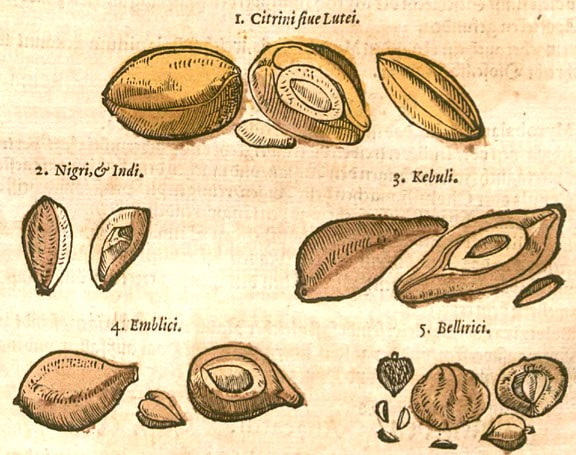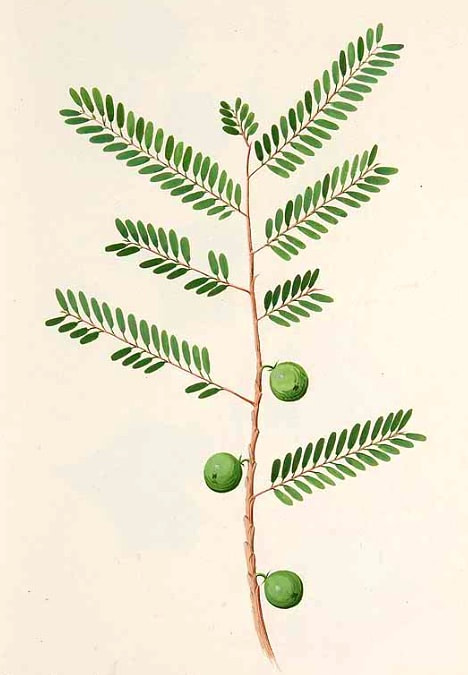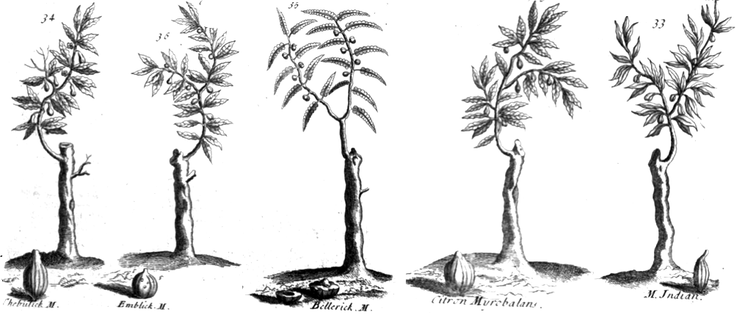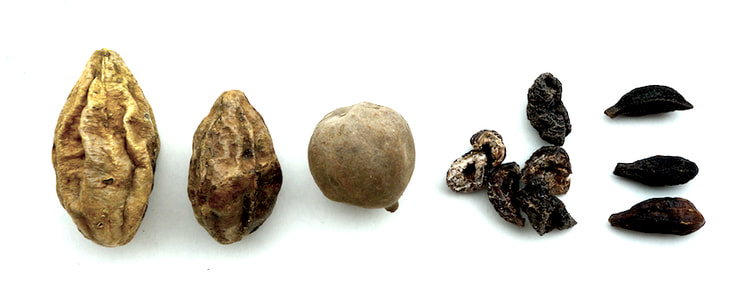Sentry Page Protection
Emblic Myrobalan
Witsen, N., Jager, H. de, Plantae Javanicae pictae, ex Java transmissae anno MDCC (1700)
Witsen, N., Jager, H. de, Plantae Javanicae pictae, ex Java transmissae anno MDCC (1700)
Chebulic, Emblic, Belleric, Citrine (Yellow) and Indian (Black) Myrobalan
A Complete History of Drugs, Pomet, London, 1748
A Complete History of Drugs, Pomet, London, 1748

1. Yellow (Citrine) Myrobalan
2. Black (Indian, Nigrum) Myroabalan
3. Chebulic Myrobalan
4. Emblic Myrobalan
5. Belleric Myrobalan
Krauterbuch, Lonitzer, 1578
Left to Right: Yellow Myrobalan, Chebulic Myrobalan, Belleric Myrobalan, Emblic Myrobalan (stoned), Black Myrobalan (Adam, 2017)
Botanical name:
Phyllanthus emblica (syn Emblica officinalis)
Parts used:
Fruits, stoned
Emblic should be fleshy, with few stones, and black externally, grey within
Temperature & Taste:
Cool and dry. Sour (all tastes except Salty in Ayurveda)
Classifications:
2S. STRENGTHENING
3B. FEBRIFUGE & ANTIPYRETIC. 3D. CORDIALS & CARDIACS.
4c. CARDIAC. 4e. STOMACHIC. 4g. HEPATIC
TCM:
B. Clear Heat
Phyllanthus emblica (syn Emblica officinalis)
Parts used:
Fruits, stoned
Emblic should be fleshy, with few stones, and black externally, grey within
Temperature & Taste:
Cool and dry. Sour (all tastes except Salty in Ayurveda)
Classifications:
2S. STRENGTHENING
3B. FEBRIFUGE & ANTIPYRETIC. 3D. CORDIALS & CARDIACS.
4c. CARDIAC. 4e. STOMACHIC. 4g. HEPATIC
TCM:
B. Clear Heat
Uses:
1. Clears Heat and Bile:
-primary medicine for Heat and Bile diseases
-clears Heat while supporting the Yin and body fluids
-clears Heat from the Blood: skin Eruptions and Skin Diseases caused by Heat and Toxin.
-other types of Heat and for Burning Feeling of the Body.
-"It reduces the Heat of Blood". (Avicenna)
-"expels Phlegm and Black Bile". (Avicenna)
2. Clears Heat, Moistens the Throat, Stops Cough:
-Lung Heat with dry Cough or dryness of the Lungs.
-Common Cold, Fever, Cough, Sore Throat
3. Clears Stomach Heat, Benefits the Spleen:
-Inflammation or Ulcers of the Stomach and Intestines
-Indigestion, Abdominal Distention (Chinese Pharmacopoeia)
-Constipation or Diarrhea coming from Heat.
-"strengthens the stomach enabling it for better coction, satisfies the Thirst, stops Vomiting and increases Appetite". (Avicenna)
4. Benefits Yin and Blood:
-strengthens hair and darkens hair color
-benefits Eyes
-"very useful for Nerves and Joints". (Avicenna)
-Diabetes, from Stomach Heat and/or Yin deficiency
-"It strengthens the roots of Hair and darkens them". (Avicenna)
5. Sattvic,
-traditionally said to bring good fortune, promoting Love and Longevity
-"strengthens and purifies the Heart and increases intellect". (Avicenna)
Dose:
Decoction: 3–9 grams
Powder: 1–3 grams
Substitute:
1. Chebulic Myrobalan (Unani)
2. Oak Galls (Waring)
3. Chinese sources regularly list Gardenia Zhi Zi in place of Emblic Myrobalan. The same is used as a substitute in Mongolia and Buryat regions.
Corrective:
1. Honey
2. Almond Oil
3. Ghee
4. See Chebula for general correctives for the Myrobalans
Comment:
1. The Myrobalans are some of the important medicines in all Traditional Medicine systems except TCM where only Chebulic Myrobalan is used, and that, sparingly. The special thing about these fruits is that they are regulators, and when used together, they can balance and regulate the Humors. Each has a regulatory effect on one of the Humors: Chebula for Wind; Emblic and Yellow Myrobalan for Blood and Bile; Belleric for Phlegm; Black Myrobalan for Melancholy.
2. The three main Myrobalans: Chebulic, Emblic and Belleric, when used together form Triphala, the Three Fruits. These are both a household remedy and the basis for some of the most complex formulas of Traditional Medicine intended to treat some of the most obstinate diseases.
3. There are a great many Myrobalan based formulas used in Traditional Medicine. These are called Triphala in Ayurveda, Itrafal in Unani and Tryphera in the West.
4. Taken in Infusion, they only purge; in Decoction, they purge and bind (purging more); the Powder purges and binds (binds more).
Decoction: 3–9 grams
Powder: 1–3 grams
Substitute:
1. Chebulic Myrobalan (Unani)
2. Oak Galls (Waring)
3. Chinese sources regularly list Gardenia Zhi Zi in place of Emblic Myrobalan. The same is used as a substitute in Mongolia and Buryat regions.
Corrective:
1. Honey
2. Almond Oil
3. Ghee
4. See Chebula for general correctives for the Myrobalans
Comment:
1. The Myrobalans are some of the important medicines in all Traditional Medicine systems except TCM where only Chebulic Myrobalan is used, and that, sparingly. The special thing about these fruits is that they are regulators, and when used together, they can balance and regulate the Humors. Each has a regulatory effect on one of the Humors: Chebula for Wind; Emblic and Yellow Myrobalan for Blood and Bile; Belleric for Phlegm; Black Myrobalan for Melancholy.
2. The three main Myrobalans: Chebulic, Emblic and Belleric, when used together form Triphala, the Three Fruits. These are both a household remedy and the basis for some of the most complex formulas of Traditional Medicine intended to treat some of the most obstinate diseases.
3. There are a great many Myrobalan based formulas used in Traditional Medicine. These are called Triphala in Ayurveda, Itrafal in Unani and Tryphera in the West.
4. Taken in Infusion, they only purge; in Decoction, they purge and bind (purging more); the Powder purges and binds (binds more).
Main Combinations:
Triphala
1. Anemia, take Emblic Myrobalan, Iron bhasma (ashes) and Licorice. (Ayurveda)
2. Constipation, Emblic Myrobalan with Chebulic Myrobalan, Psyllium (Ayurveda)
3. Hyperacidity, Gastric Ulcers, Emblic Myrobalan with Asparagus racemosus, Licorice (Ayurveda)
4. Heart diseases, Arrhythmia, Emblic Myrobalan with Arjuna, Sida cordifolia, Belleric Myrobalan (Ayurveda)
5. Chest pain, Angina, Atherosclerosis, Emblic Myrobalan, Turmeric, Bdellium, Arjuna (Ayurveda)
6. High Cholesterol, Emblic Myrobalan with Bdellium, Turmeric (Ayurveda)
7. Diabetes,
i. Emblic Myrobalan with Turmeric (Ayurveda)
ii. Emblic Myrobalan with Turmeric, Barberry (Ayurveda)
iii. Emblic Myrobalan with Tinospora, Shilajit
iv. Emblic Myrobalan with Turmeric, Gymnema, Cinnamon, Shilajit (Ayurveda)
v. Emblic Myrobalan with Gymnema, Turmeric, Neem, Shilajit, Black Pepper (Ayurveda)
8. Gout from Damp-Heat, Emblic Myrobalan, Turmeric, Cyperus rotundus
9. Liver disorders, Emblic Myrobalan with Neem, Picrorhiza, Tinospora (Ayurveda)
Major Formulas:
Triphala
Powder of Emblic Myrobalan (Amalaki Churna)
Kaisor Guggulu (Bdellium Youthful Pill) (Ayurveda)
Emblic 6 (Kyu ru duk pa) (Tibetan)
Emblic 35 (Skyu ru nyer lnga( (Tibetan)
Pills for Migraine (Galen)
‘Pills without which I would not be’ (Nicholas)
Pills to Aggregate Lesser (Mesue)
Arabian Pills (Nicholas)
Confection for Dizziness and Vertigo
Electuary of Life (Arnold de Villa Nova)
Electuarium Alcharif (Mesue)
Electuary of Micleta (Nicholas)
Gallia Aloephangina (Aromatic Troches) (Mesue)
Triphala Electuary of Raisins (Unani)
Triphera of Dodder of Thyme (Mesue)
Triphala Electuary of Dodder (Unani)
Triphala Electuary of Fennel Seeds (Unani)
Triphala Electuary for Epilepsy (Itrifal Zabeeb)
Triphera Persica (Mesue)
Triphera of the Saracens (Triphera Saracenica Magna)
Triphera Minor (Triphera Phoenonis) (Mesue)
Triphala Electuary Lesser (Unani)
Triphala Electuary Greater (Unani)
Triphala Electuary to Purge Phlegm and Black Bile
Blood Medicine 7 (Khrag sman bdun pa) (Tibetan)
Nutmeg Powder (Jatiphaladi Churna) (Ayurveda)
Frankincense 10 (Spos dkar 10) (Tibetan)
Mild Medicine (Tibetan)
Cautions:
1. Safe and well tolerated. Sometimes causes constipation and colic which is usually corrected in formula.
2. Mesue said the only deleterious effect of the Myrobalans was their potential to create obstruction. This is why they are regularly mixed with Ghee or Oil and Honey in Ayurveda and Unani. They are also used with medicines to prevent likelihood of obstruction such as Stoechas, Indian Spikenard, Ginger or Pepper etc.
3. Pemell said they should not be used in Obstruction or Fever. They are sometimes used in formulas in these cases with appropriate medicines.
Main Preparations used:
Confected Emblic Myrobalan, Paste of fresh Emblic Myrobalan, Pickled Emblic Myrobalan
1. Safe and well tolerated. Sometimes causes constipation and colic which is usually corrected in formula.
2. Mesue said the only deleterious effect of the Myrobalans was their potential to create obstruction. This is why they are regularly mixed with Ghee or Oil and Honey in Ayurveda and Unani. They are also used with medicines to prevent likelihood of obstruction such as Stoechas, Indian Spikenard, Ginger or Pepper etc.
3. Pemell said they should not be used in Obstruction or Fever. They are sometimes used in formulas in these cases with appropriate medicines.
Main Preparations used:
Confected Emblic Myrobalan, Paste of fresh Emblic Myrobalan, Pickled Emblic Myrobalan
Click the Tabs above for more information on this Medicine
|
'The fruit of this tree is the Dhatriphala, Amritaphala, Amalaka or Sriphala of the Nighantas, and is described as having all the properties of the chebulic myrobalan. It is used both fresh and dried; in the former condition it is considered to be refrigerant, diuretic and laxative; in the latter, astringent. It is pickled by the natives, and, on account of a peculiar flavour which it imparts, some of the forest tribes eat it. before drinking water. A sherbet of the fruit, sweetened with sugar or honey, is a favourite cooling drink for sick people; it is said to be diuretic. A country-side prescription for biliousness in the Concan is Axala, 4 massas, to be soaked all night in water, and in the morning to be pounded and mixed with a quarter seer of milk and flavoured with sugar and cumin. Emblic myrobalans are an ingredient in many compound preparations described in Sanskrit works. A selection of these prescriptions will be found in Butt's Hindu Materia Medica; the following, translated from Chakradatta, may be taken as an example:—
"Dhatri lauha.—Take of powdered Emblic myrobalans 64 tolas, prepared iron 32 tolas, liquorice powder 16 tolds, mix them together, and soak in the juice of Tinospora cordifolia seven times successively. |
This preparation is given in jaundice, anaemia and dyspepsia, in doses of from 20 to 40 grains."
Mahometan physicians esteem this myrobalan equally with the Hindus ;they describe it as astringent, refrigerant, cardiacal, and a purifier of the humors of the body. It is much prescribed by them in fluxes, and is also applied externally on account of its cooling and astringent properties. The Arabic name is Amlaj, and the Persian Amala. Ainslie states that the flowers, which have an odour resembling that of lemon peel, are supposed by the Vytians to have virtues of a cooling and aperient nature, and are prescribed in conjunction with other articles in the form of an electuary. {Mat. Ind., ii., p. 244.) In the Pharmacopoeia of India it is stated, upon the authority of Dr. M. Ross, that the root by decoction and evaporation yields an astringent extract equal to catechu, both for medicinal purposes and in the arts; the chips of the wood or small branches thrown into impure or muddy water, according to the same authority, clear it effectually. In the Concan the juice of the fresh bark, with honey and turmeric, is given in gonorrhoea. (Pharmacographia Indica, Dymock, 1893) |
Research




